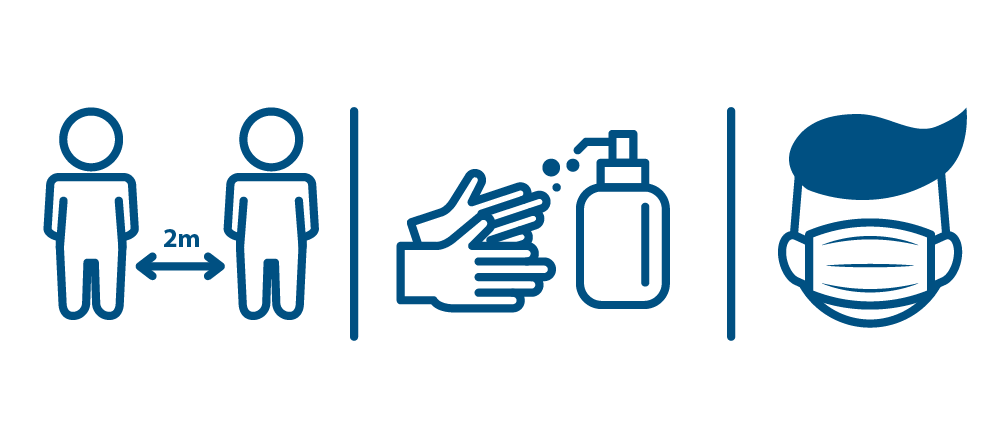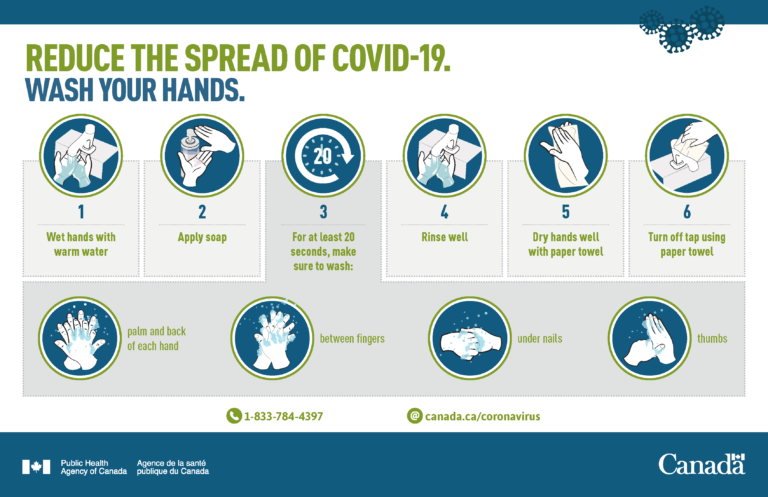Reducing the Spread of COVID-19
By making a conscious effort to follow a few simple yet effective guidelines we can reduce the spread of COVID-19 and other viruses. We can all do our part.
If you are experiencing symptoms of COVID-19, isolate yourself immediately and use the Health Canada Online Symptom Checker.
Physical Distancing
Physical distancing is proven to be one of the most effective ways to reduce the spread of illness during an outbreak. It starts with staying 2m from others, but there’s more to it than that. Physical distancing also means:
- Avoiding crowded places. Shop during off peak hours or request delivery or pickup.
- Limiting non-essential outings. Plan ahead so you can complete multiple errands during one trip out.
- Avoiding hugs and handshakes. Wave and smile instead.
- Staying home when you’re feeling ill, even if you’re not quite sure or you think it might be ‘just allergies’.
- Limiting your contact with people at higher risk for complications such as the elderly or those with underlying conditions or compromised immunity, even when you have no symptoms.
Hand Hygiene
Sanitize as often as possible while you are out. Wash immediately upon returning home. Soap and water is the gold standard.
When soap and water is not available, use hand sanitizer that contains at least 60% alcohol. Use an amount sufficient enough to cover both hands and rub in until its completely absorbed.
Be discerning when purchasing hand sanitizer. Ensure it has been approved for use by Health Canada. Click for a complete list of approved products. Do not attempt to create your own homemade sanitizer, it’s likely to be ineffective and may present other health risks.
Respiratory Etiquette
Reduce the spread of respiratory droplets by coughing or sneezing into a tissue or the bend of your arm. Dispose of any tissues you’ve used as soon as possible in a closed, lined waste basket, then wash your hands. Avoid touching your eyes, nose, or mouth with unwashed hands.
Wear a mask
Masks can limit the spread of respiratory droplets between people and on surfaces. It also stops you from touching your face. Your mask should completely cover the nose and mouth without gaping, and be secured to your head by ties or ear loops. Reusable masks should be made with at least two layers of tightly woven fabric. Click for the complete low-down on wearing and caring for your non-medical mask.
Household Cleaning
Viruses are most likely to be on surfaces you frequently touch with your hands. Regularly clean and disinfect high-touch surfaces.
- Tables and counter tops
- Toilets and faucets
- Doorknobs, handles and light switches
- Remotes, phones and other electronics
- Frequently touched areas of your vehicle such as the steering wheel, door handles, and media display
Use caution when handling household cleaning products. Always follow the manufacturers instructions. Never mix household cleaners together as this may cause a dangerous chemical reaction producing toxic fumes. If you are using a diluted bleach solution, the safest and most effective ratio is I teaspoon (5ml) of bleach to I cup (250ml) of water. Always add bleach to water, never the other way around.


